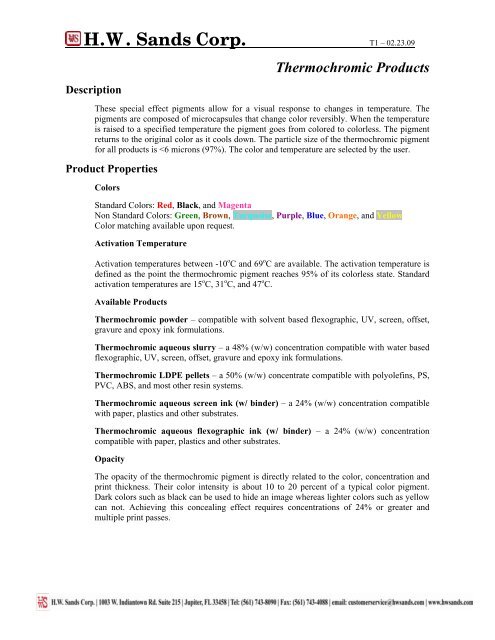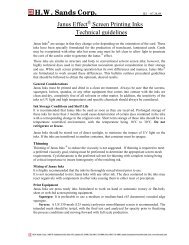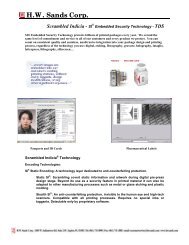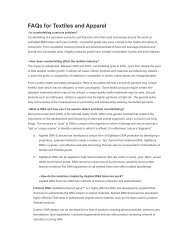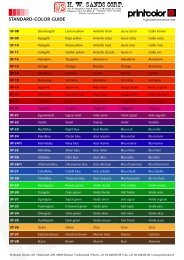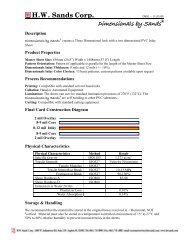Thermochromic Products - H.W. Sands Corporation
Thermochromic Products - H.W. Sands Corporation
Thermochromic Products - H.W. Sands Corporation
- No tags were found...
Create successful ePaper yourself
Turn your PDF publications into a flip-book with our unique Google optimized e-Paper software.
H.W. <strong>Sands</strong> Corp. T1 – 02.23.09<br />
Description<br />
<strong>Thermochromic</strong> <strong>Products</strong><br />
These special effect pigments allow for a visual response to changes in temperature. The<br />
pigments are composed of microcapsules that change color reversibly. When the temperature<br />
is raised to a specified temperature the pigment goes from colored to colorless. The pigment<br />
returns to the original color as it cools down. The particle size of the thermochromic pigment<br />
for all products is
H.W. <strong>Sands</strong> Corp. T1 – 02.23.09<br />
Application Suggestions<br />
Solvent Compatibility<br />
The thermochromic pigments are sensitive to most polar solvents. Below is a list of<br />
compatible and non-compatible solvents.<br />
Compatible Solvents<br />
Glycols Water Xylene Mineral Spirits<br />
Isobutanol Ethanol Methyl Pyrrolidone High Chain Acetates<br />
White Spirits High Chain Ketones High Chain Alcohols Butanone Oxime<br />
Toluene Naptha Silicones<br />
Non-Compatible Solvents<br />
Acetone PMA Propyl Acetate Ammonia<br />
Recommended Concentrations for Ink, Paint and Plastic Formulations<br />
Ink/Paint<br />
(Solvent)<br />
Ink/Paint<br />
(Aqueous)<br />
Plastic<br />
Injection/Extrusion<br />
<strong>Thermochromic</strong> Powder Aqueous Slurry Powder / LDPE<br />
Pellets<br />
Concentration 15%-30% 15%-30% 3.0%-5.0%<br />
Dispersing/Mixing<br />
The thermochromic pigments are compatible with standard mixing procedures. Be careful not<br />
to grind or damage the pigment through aggressive dispersion techniques (e.g. Bead Mills).<br />
This will destroy the structure of the microcapsules and color changing properties.<br />
Initially mix the thermochromic pigment with a low viscosity material. Once this is<br />
thoroughly mixed, slowly add any higher viscosity material and continue to mix.<br />
If you are having trouble with the dispersion, it is suggested to moisten the thermochromic<br />
powder into a cream form. This can be done by adding a small amount of solvent to the full<br />
quantity of thermochromic pigments to be used. Once the solvent is added, gently fold the<br />
mixture in order to form a cream. Add this mixture to a lower viscosity base and continue<br />
mixing.<br />
The ink base should have good transparency properties. If the resulting ink layer exhibits a<br />
bumpy look additional mixing maybe required, or it is suggested to apply a clear overcoat<br />
over the printed thermochromic layer.<br />
Printing Recommendations<br />
General Considerations<br />
<strong>Thermochromic</strong> inks must be printed and dried in a clean environment. Always be sure that<br />
the screens, squeegees, knives, spatulas, or any other equipment that comes into contact with<br />
the thermochromic inks are clean and dry, completely free of all solvents or other matter. In<br />
addition, the sensitivity of the thermochromic inks to UV light and high temperatures and<br />
specific chemicals should always be considered.
H.W. <strong>Sands</strong> Corp. T1 – 02.23.09<br />
Stability<br />
Aqueous Flexographic Ink<br />
The recommended anilox is 200, and less than 150 where high color intensity is required. A<br />
hard sticky back should be used; rubber plates with soft durometer and very little nip pressure<br />
should be applied. A doctor blade is recommended over a metering roller. If your doctor<br />
blade is metallic, the anilox used should be ceramic.<br />
Aqueous Screen Ink<br />
The thermochromic aqueous screen inks are press ready inks formulated to work on hand or<br />
automatic (rotary or flat-bed), sheet or web-fed screen printing equipment. A US 80-150<br />
mesh polyester monofilament screen or lower is recommended. It is preferable to use a<br />
medium or medium-hard (65 durometer) rounded edge squeegee. When drying the ink do not<br />
exceed 70 o C.<br />
Heat<br />
Extended exposure to temperatures of >50 o C can lead to degradation of the pigment. The<br />
thermochromic pigments can survive temperatures >200 o C, however, if exposure is limited to<br />


